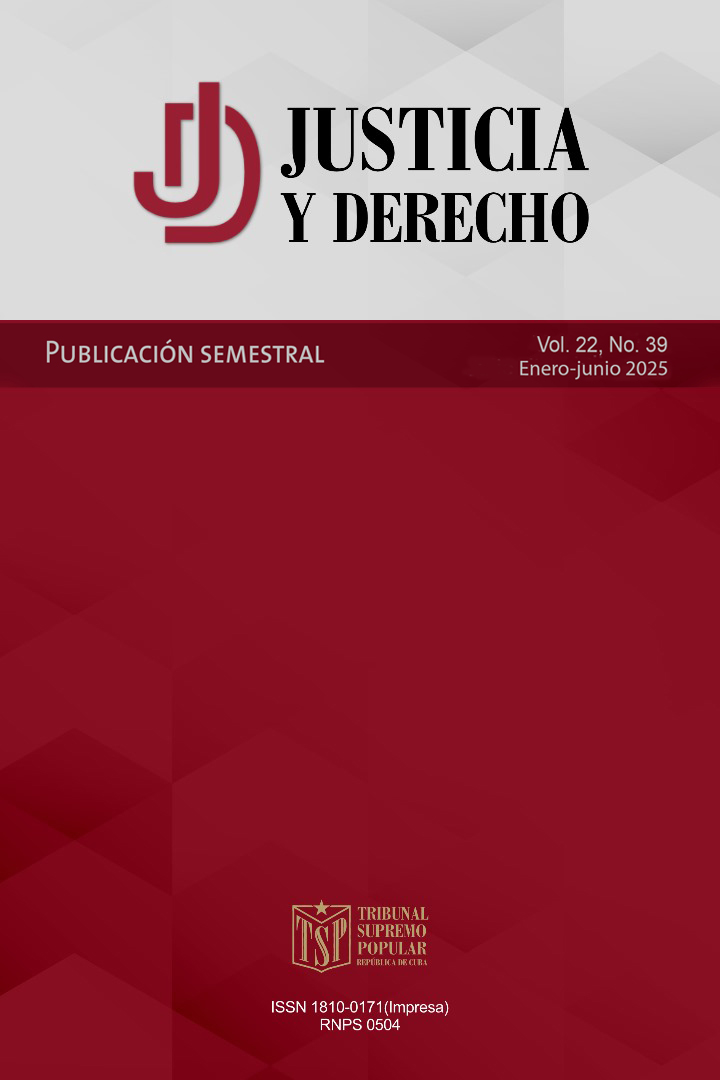Breaking barriers from a judicial perspective: Easy-to-read judgements
Main Article Content
Abstract
The preparation of judgments in an easy-to-read format is a novel issue in the practice and doctrine of procedural law that has gained followers and detractors. This debate has given rise to the need to design a balanced procedural model in which the judge is capable of adjusting procedures, which should mean providing him with powers in the formal and material order that fill the jurisdictional function with content, so that he has the procedural tools to pursue, from an impartial and independent stance, the realisation of justice. The drafting of judgments in this form is presented as a guarantee of the effective judicial protection of citizens' rights. In accordance with these assumptions, the institution under study appears in the procedural norms. A look at foreign legal systems indicates points of contact with Cuban legislation, in which the figure of a judge who uses all his or her powers to procedurally adjust the administration of justice continues to be a challenge, which this paper approaches with the aim of making proposals to perfect its regulation and stimulate its use in national judicial practice.
Downloads
Article Details

This work is licensed under a Creative Commons Attribution-NonCommercial 4.0 International License.
References
Antolín Marsal, R. (s.f) Manual de lectura fácil y formatos accesibles. Consejo Nacional para la Igualad de Discapacidades. https:// www.google.com/url?sa=t&source=web&rct=j&opi=899 78449&url=https://www.iddcconsortium.net/wp-content/ uploads/2021/07/Manual-de-lectura-f%25C3%25A1cil-y-formatos-accesibles.f&ved=2ahUKEwjf_8aEx5iKAxUHibAFHb qRLCsQFnoECCwQAQ&usg=AOvVaw1Sa1LNGsGsZT5HIsGD azHw
Ato Alvarado, M. E. (Julio-diciembre, 2021). El lenguaje claro y la transparencia de las decisiones judiciales. Revista Oficial del Poder Judicial, 13(16), 61-76. https://doi.org/10.35292/ropj. v13i16.450
Bullard González, A. (2019). Análisis económico del Derecho. Pontificia Universidad Católica del Perú.
Cappelletti, M. y Garth, B. (1972). La oralidad y las pruebas en el proceso civil. Ediciones Jurídicas Europa-América.
Cappelletti, M. y Garth, B. (1983). El acceso a la justicia (Amaral, S., trad.). Colegio de Abogados del Departamento Judicial de La Plata.
Consejo de Gobierno, Tribunal Supremo Popular. (Febrero 1.o, 2022). Instrucción No. 265. GOR-E, (13), 717-725. https://www. gacetaoficial.gob.cu/sites/default/files/goc-2022-ex13.pdf
Consejo de Gobierno, Tribunal Supremo Popular. (Febrero 14, 2023). Instrucción No. 278. GOR-E, (11), 35-42. https://www. gacetaoficial.gob.cu/sites/default/files/goc-2023-ex11.pdf
Constitución española (ed. conmemorativa del cuadragésimo aniversario). (2018). Cortes Generales.
Constitución de la República de Cuba. (Abril 10, 2019). GOR-E, (5), 69-116.
Cumbre Judicial Iberoamericana. (2024). Las Reglas de Brasilia. https://www.cumbrejudicial.org/sites/default/files/2024-02/ Documento%205-Edic%C3%B3n%20Reglas&20deBrasilia- Texto%20y%20Comentarios20de%20Joaqu%C3%ADn%20 Delgado%20Mart%C3%ADn.pdf
Comisión Estatal de Derechos Humanos de Nuevo León. (2011). Grupos en situación de vulnerabilidad. https://www. cedhnl.org.mx/imagenes/publicaciones/presentaciones/ CEDHNL_VIISeminarioDHS/ModuloII/Grupos-en-situacion-de-vulnerabilidad.pdf
Durán Alonso, S. (2023). Accesibilidad al proceso y menores de edad: desde la figura del facilitador hasta las resoluciones «de lectura fácil». En Martínez Calvo, J. (Coord.). La protección jurídica del menor en el Derecho comparado, 187- 203. Prensas.
Fairén Guillén, V. (1955). Estudios de Derecho procesal. Revista de Derecho Privado.
Fernández Bulté, J. (2008). Siete milenios de Estado y de Derecho (t. I). Editorial de Ciencias Sociales.
García Muñoz, O. (2011). Lectura fácil: Métodos de redacción y evaluación. Editorial Real Patronato sobre Discapacidad.
Ley No. 141, «Código de procesos». (Diciembre 7, 2021). GOR-O, (138), 3977-4069.
Ley No. 143, «Del proceso penal». (Diciembre 7, 2021). GOR-O, (140), 4095-4251.
López Cabello, A., Trovato, M., Griffa, T. y Morales, D. (2016). El acceso a la justicia como una cuestión de derechos humanos. En Derechos humanos en la Argentina. Informe 2016, 271-297. https://www.cels.org.ar/web/wp-content/ uploads/2016/12/IA2016-09-acceso-a-la-justicia.pdf
Organización de Naciones Unidas. (1994). Normas uniformes sobre la igualdad de oportunidades para las personas con discapacidad. https://www.ohchr.org/es/instruments-mechanisms/instruments/standard-rules-equilization-opportunities-persons-disabilities
Pérez Gutiérrez, I. y Hierro Sánchez, L. A. (2019). La tutela judicial efectiva en el proceso civil. Leyer.
Poblete, C. y Fuenzalida González, P. (2018). Una mirada al uso de lenguaje claro en el ámbito judicial latinoamericano. Lengua i Dret, (69), 119-138. https://urbeetius.org/articulos-argumentacion-redaccion-juridica-y-lenguaje-claro/ una-mirada-al-uso-de-lenguaje-claro-en-el-ambito-judicial-latinoamericano/
Sanz, I. (2021). Las sentencias de ´lectura fácil´, una traducción para personas con discapacidad que se implanta lentamente. https://www.telecinco.es/noticias/espana/sentencias-lectura-facil-traduccion-personas-discapacidad_18_3219047058.html
Suárez de los Santos, D. C. (Coord.). (2022). Guía para elaborar sentencias en formato de lectura fácil dirigidas a personas con discapacidad intelectual. Suprema Corte de Justicia de la Nación. https://www.scjn.gob.mx/derechos-humanos/ sites/default/files/Publicaciones/archivos/2022-12/ Gu%C3%ADa%20para%20elaborar%20sentencias%20en%20 formato%20de%20lectura%20f%C3%A1cil%20para%20 pcd%20intelectual.pdf
